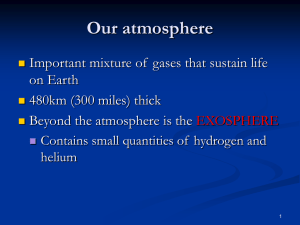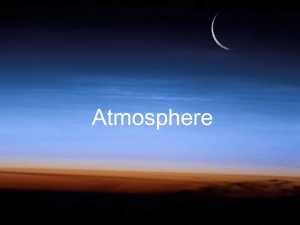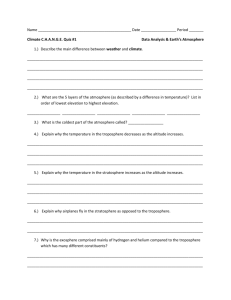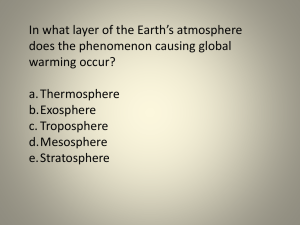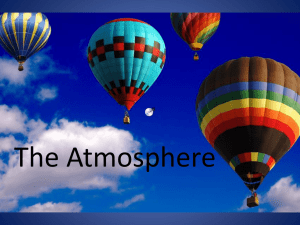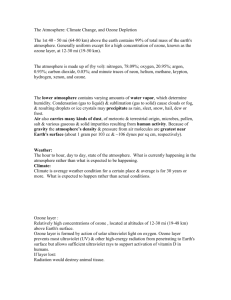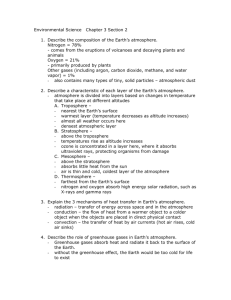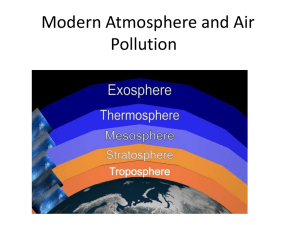Atmosphere
advertisement
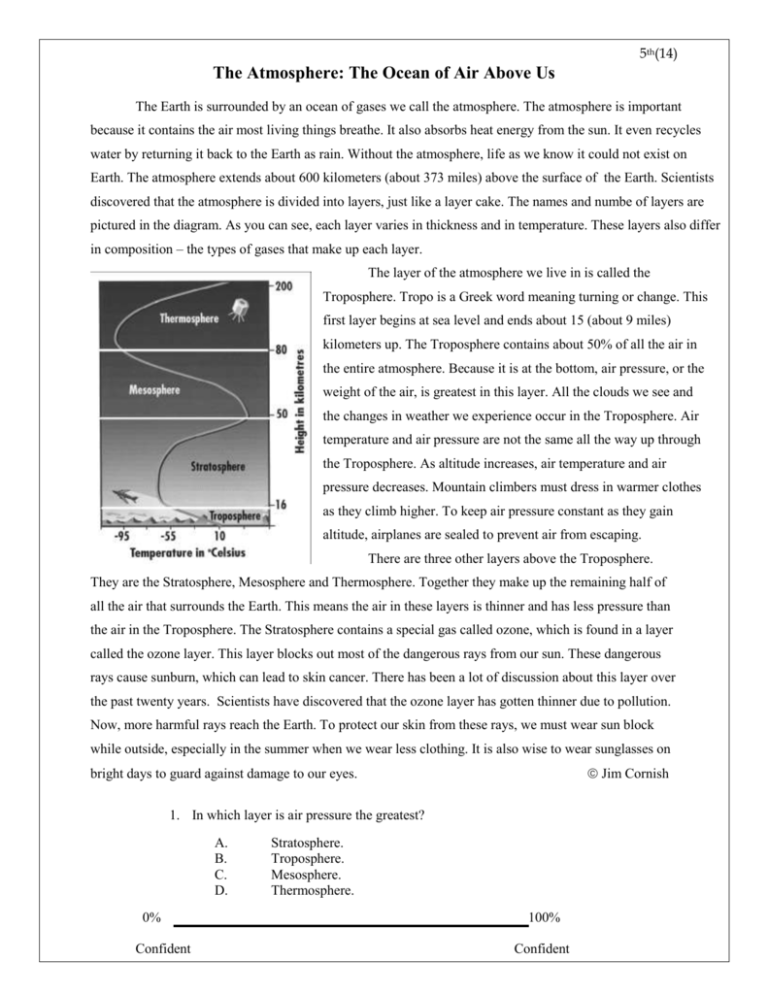
5th(14) The Atmosphere: The Ocean of Air Above Us The Earth is surrounded by an ocean of gases we call the atmosphere. The atmosphere is important because it contains the air most living things breathe. It also absorbs heat energy from the sun. It even recycles water by returning it back to the Earth as rain. Without the atmosphere, life as we know it could not exist on Earth. The atmosphere extends about 600 kilometers (about 373 miles) above the surface of the Earth. Scientists discovered that the atmosphere is divided into layers, just like a layer cake. The names and numbe of layers are pictured in the diagram. As you can see, each layer varies in thickness and in temperature. These layers also differ in composition – the types of gases that make up each layer. The layer of the atmosphere we live in is called the Troposphere. Tropo is a Greek word meaning turning or change. This first layer begins at sea level and ends about 15 (about 9 miles) kilometers up. The Troposphere contains about 50% of all the air in the entire atmosphere. Because it is at the bottom, air pressure, or the weight of the air, is greatest in this layer. All the clouds we see and the changes in weather we experience occur in the Troposphere. Air temperature and air pressure are not the same all the way up through the Troposphere. As altitude increases, air temperature and air pressure decreases. Mountain climbers must dress in warmer clothes as they climb higher. To keep air pressure constant as they gain altitude, airplanes are sealed to prevent air from escaping. There are three other layers above the Troposphere. They are the Stratosphere, Mesosphere and Thermosphere. Together they make up the remaining half of all the air that surrounds the Earth. This means the air in these layers is thinner and has less pressure than the air in the Troposphere. The Stratosphere contains a special gas called ozone, which is found in a layer called the ozone layer. This layer blocks out most of the dangerous rays from our sun. These dangerous rays cause sunburn, which can lead to skin cancer. There has been a lot of discussion about this layer over the past twenty years. Scientists have discovered that the ozone layer has gotten thinner due to pollution. Now, more harmful rays reach the Earth. To protect our skin from these rays, we must wear sun block while outside, especially in the summer when we wear less clothing. It is also wise to wear sunglasses on Jim Cornish bright days to guard against damage to our eyes. 1. In which layer is air pressure the greatest? A. B. C. D. 0% Confident Stratosphere. Troposphere. Mesosphere. Thermosphere. 100% Confident 5th(14) 2. What does the word composition mean in this passage? A. B. C. D. Process material so that it is used again. The way the parts of something are arranged. To keep the air pressure constant. Music notes written on a page 0% 100% Confident Confident 3. An alternate title for this reading passage might be: A. B. C. D. 0% The Thinning Ozone Layer. Air Pressure and the Atmosphere. Weather Events and the Atmosphere. The Many Layers of the Atmosphere. 100% Confident Confident 4. Why did the word Troposphere come from the Greek word tropo? A. B. C. D. 0% Greeks first discovered the atmosphere. Tropo is the Greek god of weather. The weather is always changing within the Troposphere. The Earth is shaped like a sphere 100% Confident Confident 5. How are health problems in humans caused by the thinning ozone layer? A. B. C. D. 0% Confident More harmful rays from the sun reach Earth. It allows pollution to reach the Earth. There is less ozone for humans to breathe. The thinning ozone layer is increasing the air pressure on humans. 100% Confident On a scale between 1 and 10 with 1 being low and 10 being how well did you like this passage? Didn’t I Really Like It 1 2 3 4 5 6 7 8 9 10 Liked It At All Inference: Which layer of the atmosphere is the most important to humans? Why?

